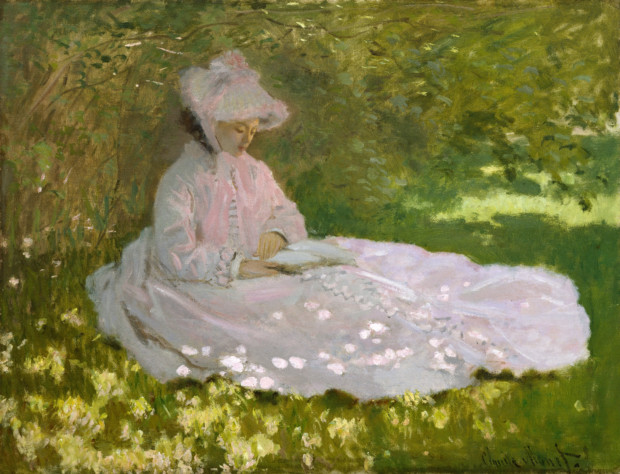4 Delicious Still Lifes to (Re)Discover Claude Monet
Amazing Impressionist landscapes, wonderful water lilies, the floral explosion at the famous Giverny garden… But what is perhaps less known...
Andra Patricia Ritisan 14 November 2024
Claude Monet’s Springtime depicts his first wife, Camille Doncieux, who is absorbed by reading in the shadow of lilacs. The painting is presently held by the Walters Art Museum.
Camille Doncieux was a beautiful and talented model who worked with many artists of the time, Auguste Renoir and Édouard Manet often depicted Camille in their paintings. During the 1860s and 1870s, she modeled for Monet’s figurative paintings and eventually became his mistress and later – wife. After marriage, Camille continued being Monet’s muse and often was a main character in the artist’s early painting of domestic life scenes.

Late in the year 1871, Monet, Camille, and their son settled in Argenteuil, a village Northwest of Paris. Argenteuil was a popular resort for Parisians as it had a perfect train connection to the city and was always a good choice for a holiday retreat. The Monet family was frequently visited by Impressionists who adored the village and the surrounding nature. Monet himself would often paint in the garden portraying his wife and son, as well as Alfred Sisley’s companion, Adélaïde-Eugénie Lescouezec. That is how Springtime was created as well.
It is a very sentimental work that shows the beauty of calm family life. The whole scene speaks about the tenderness of the moment. Monet portrays Camille in a fashionable pink dress resting under the canopy. The light gets through leaving a pattern on the grass and the dress of the model ( they look nearly like cherry blossom petals don’t they). Camille is preoccupied with reading, she seems relaxed and comfortable with her husband documenting the moment. It is indeed a very simple scene but at the time Monet cherished the beauty which is hidden in such simplicity.
Four years later Springtime was displayed on the first Impressionist exhibition organized at Durand Ruel’s Paris Gallery, which took place from March 30 to April 30, 1876. In total Monet exhibited 18 works there, 6 of which featured his beloved wife Camille. The name actually changed, and instead of Springtime, the work was given a “simpler” title – Woman Reading. But Springtime is much more pleasant, isn’t it?
Sadly, Camille Monet died in 1879. The second wife of Monet, Alice Hoschedé, ordered to destroy of all pictures and mementos from Camille’s life with Monet, but the memory of Cammile survived thanks to the works she posed for. We are lucky that there are so many of them.
DailyArt Magazine needs your support. Every contribution, however big or small, is very valuable for our future. Thanks to it, we will be able to sustain and grow the Magazine. Thank you for your help!